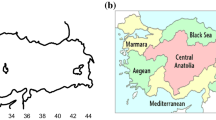Abstract
The study of environmental problems usually requires the description of variables with different nature and the assessment of relations between them. In this work, an algorithm for flexible estimation of the joint density for a circular–linear variable is proposed. The method is applied for exploring the relation between wind direction and SO2 concentration in a monitoring station close to a power plant located in Galicia (NW–Spain), in order to compare the effectiveness of precautionary measures for pollutants reduction in two different years.










Similar content being viewed by others
References
Agostinelli C, Lund U (2011) Circular: circular statistics. R package version 0.4-3. https://r-forge.r-project.org/projects/circular/. Accessed 23 July 2011
Azzalini A (1981) A note on the estimation of a distribution function and quantiles by a kernel method. Biometrika 68: 326–328
Bayraktar H, Turalioğlu FS, Tuncel G (2010) Average mass concentrations of TSP, PM10 and PM2.5 in Erzurum urban atmosphere, Turkey. Stoch Environ Res Risk Assess 24:57–65
Chen C-C, Wu K-Y, Chang-Chien G-P (2011) Point source identification using a simple permutation test: a case study of elevated PCDD/F levels in ambient air and soil and their relation to the distance to a local municipal solid waste incinerator. Stoch Environ Res Risk Assess 26:225–233
Deschepper E, Thas O, Ottoy JP (2008) Tests and diagnostic plots for detecting lack-of-fit for circular–linear regression models. Biometrics 64:912–920
Duong T, Hazelton ML (2003) Plug-in bandwidth matrices for bivariate kernel density estimation. Nonparametr Stat 15:17–30
Fernández-Durán JJ (2004) Circular distributions based on nonnegative trigonometric sums. Biometrics 60:499–503
Fernández-Durán JJ (2007) Models for circular–linear and circular–circular data constructed from circular distributions based on nonnegative trigonometric sums. Biometrics 63:579–585
Gijbels I, Mielniczuk J (1990) Estimating the density of a copula function. Communications in statistics. Theory Methods 19:445–464
Hall P, Watson GS, Cabrera J (1987) Kernel density estimation with spherical data. Biometrika 74:751–762
Jammalamadaka SR, Lund UJ (2006) The effect of wind direction on ozone levels: a case study. Environ Ecol Stat 13:287–298
Jammalamadaka SR, SenGupta A (2001) Topics in circular statistics. World Scientific Press. Singapore
Johnson ME (1987) Multivariate statistical simulation. Wiley series in probability and mathematical statistics. Wiley, New York
Johnson RA, Wehrly T (1978) Some angular–linear distributions and related regression models. J Am Stat Assoc 73:602–606
Mardia KV, Jupp PE, (2000) Directional statistics. Wiley series in probability and statistics. Wiley, Chichester
Nazemi A, Elshorbagy A (2012) Application of copula modelling to the performance assessment of reconstructed watersheds. Stoch Environ Res Risk Assess 26:189–205.
Nelsen RB (2006) An introduction to Copulas. Springer series in statistics. Springer, New York
Omelka M, Gijbels I, Veraverbeke N (2009) Improved kernel estimation of copulas: weak convergence and goodness-of-fit testing. Ann Statist 37:3023–3058
R Development Core Team (2011) R: a language and environment for statistical computing. R Foundation for Statistical Computing, Austria
Ruppert D, Wand MP (1994) Multivariate locally weighted least squares regression. Ann Stat 22:1346–1370
Sheather SJ, Jones MC (1991) A reliable data-based bandwidth selection method for kernel density estimation. J R Stat Soc B 53:683–690
Shih DC–F (2008) Wind characterization and potential assessment using spectral analysis. Stoch Environ Res Risk Assess 22:247–256
Taylor CC (2008) Automatic bandwidth selection for circular density estimation. Comput Stat Data Anal 52:3493–3500
Wand MP, Jones MC (1995) Kernel smoothing. Chapman and Hall, London
Wehrly T, Johnson RA (1979) Bivariate models for dependence of angular observations and a related Markov process. Biometrika 67:255–256
Acknowledgements
The authors acknowledge the support of Project MTM2008–03010, from the Spanish Ministry of Science and Innovation and Project 10MDS207015PR from Dirección Xeral de I+D, Xunta de Galicia. Work of E. García-Portugués has been supported by FPU grant AP2010–0957 from the Spanish Ministry of Education. We also thank the referee and the Associate Editor for providing constructive comments and help in improving this paper.
Author information
Authors and Affiliations
Corresponding author
Rights and permissions
About this article
Cite this article
García-Portugués, E., Crujeiras, R.M. & González-Manteiga, W. Exploring wind direction and SO2 concentration by circular–linear density estimation. Stoch Environ Res Risk Assess 27, 1055–1067 (2013). https://doi.org/10.1007/s00477-012-0642-5
Published:
Issue Date:
DOI: https://doi.org/10.1007/s00477-012-0642-5




